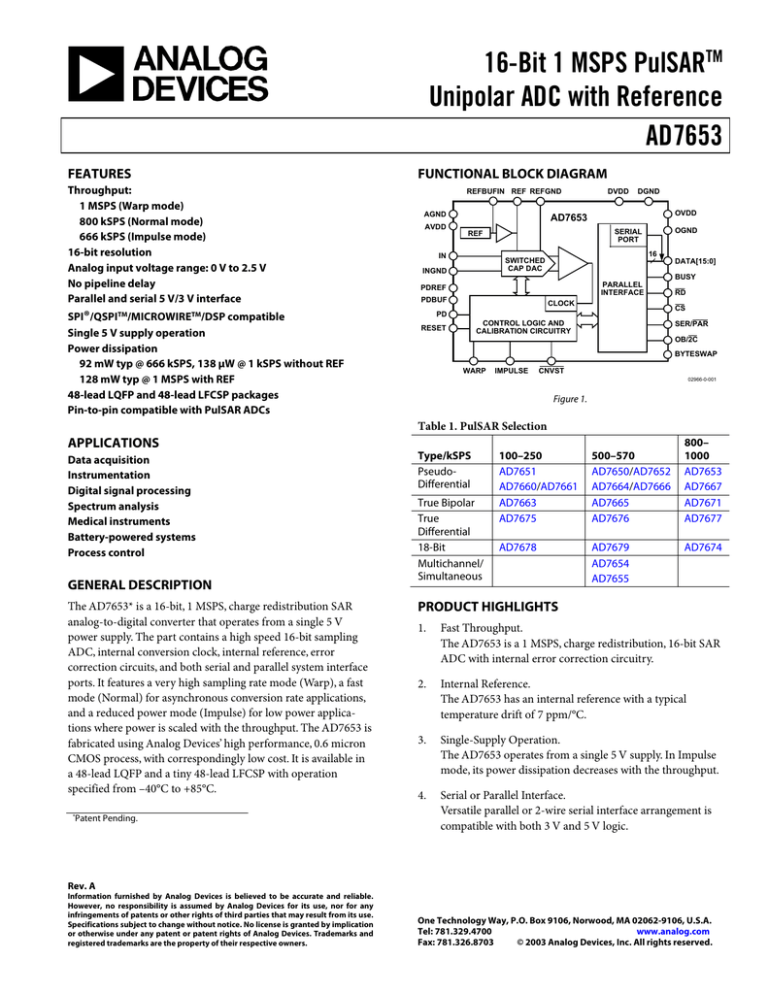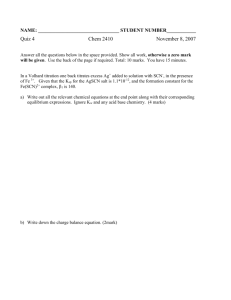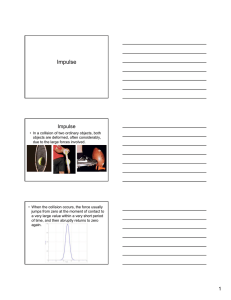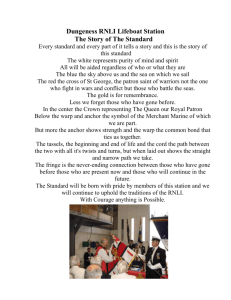
16-Bit 1 MSPS PulSARTM
Unipolar ADC with Reference
AD7653
FEATURES
Throughput:
1 MSPS (Warp mode)
800 kSPS (Normal mode)
666 kSPS (Impulse mode)
16-bit resolution
Analog input voltage range: 0 V to 2.5 V
No pipeline delay
Parallel and serial 5 V/3 V interface
SPI®/QSPITM/MICROWIRETM/DSP compatible
Single 5 V supply operation
Power dissipation
92 mW typ @ 666 kSPS, 138 µW @ 1 kSPS without REF
128 mW typ @ 1 MSPS with REF
48-lead LQFP and 48-lead LFCSP packages
Pin-to-pin compatible with PulSAR ADCs
FUNCTIONAL BLOCK DIAGRAM
REFBUFIN REF REFGND
AGND
AVDD
DVDD
DGND
OVDD
AD7653
REF
IN
16
SWITCHED
CAP DAC
INGND
OGND
SERIAL
PORT
PARALLEL
INTERFACE
PDREF
PDBUF
CLOCK
BUSY
RD
CS
PD
CONTROL LOGIC AND
CALIBRATION CIRCUITRY
RESET
DATA[15:0]
SER/PAR
OB/2C
BYTESWAP
WARP
IMPULSE
CNVST
02966-0-001
Figure 1.
Table 1. PulSAR Selection
APPLICATIONS
Data acquisition
Instrumentation
Digital signal processing
Spectrum analysis
Medical instruments
Battery-powered systems
Process control
GENERAL DESCRIPTION
The AD7653* is a 16-bit, 1 MSPS, charge redistribution SAR
analog-to-digital converter that operates from a single 5 V
power supply. The part contains a high speed 16-bit sampling
ADC, internal conversion clock, internal reference, error
correction circuits, and both serial and parallel system interface
ports. It features a very high sampling rate mode (Warp), a fast
mode (Normal) for asynchronous conversion rate applications,
and a reduced power mode (Impulse) for low power applications where power is scaled with the throughput. The AD7653 is
fabricated using Analog Devices’ high performance, 0.6 micron
CMOS process, with correspondingly low cost. It is available in
a 48-lead LQFP and a tiny 48-lead LFCSP with operation
specified from –40°C to +85°C.
*
Patent Pending.
Type/kSPS
PseudoDifferential
True Bipolar
True
Differential
18-Bit
Multichannel/
Simultaneous
100–250
AD7651
AD7660/AD7661
AD7663
AD7675
500–570
AD7650/AD7652
AD7664/AD7666
AD7665
AD7676
AD7678
AD7679
AD7654
AD7655
800–
1000
AD7653
AD7667
AD7671
AD7677
AD7674
PRODUCT HIGHLIGHTS
1.
Fast Throughput.
The AD7653 is a 1 MSPS, charge redistribution, 16-bit SAR
ADC with internal error correction circuitry.
2.
Internal Reference.
The AD7653 has an internal reference with a typical
temperature drift of 7 ppm/°C.
3.
Single-Supply Operation.
The AD7653 operates from a single 5 V supply. In Impulse
mode, its power dissipation decreases with the throughput.
4.
Serial or Parallel Interface.
Versatile parallel or 2-wire serial interface arrangement is
compatible with both 3 V and 5 V logic.
Rev. A
Information furnished by Analog Devices is believed to be accurate and reliable.
However, no responsibility is assumed by Analog Devices for its use, nor for any
infringements of patents or other rights of third parties that may result from its use.
Specifications subject to change without notice. No license is granted by implication
or otherwise under any patent or patent rights of Analog Devices. Trademarks and
registered trademarks are the property of their respective owners.
One Technology Way, P.O. Box 9106, Norwood, MA 02062-9106, U.S.A.
Tel: 781.329.4700
www.analog.com
Fax: 781.326.8703
© 2003 Analog Devices, Inc. All rights reserved.
AD7653
SPECIFICATIONS
Table 2. –40°C to +85°C, AVDD = DVDD = 5 V, OVDD = 2.7 V to 5.25 V, unless otherwise noted
Parameter
RESOLUTION
ANALOG INPUT
Voltage Range
Operating Input Voltage
Analog Input CMRR
Input Current
Input Impedance1
THROUGHPUT SPEED
Complete Cycle
Throughput Rate
Time between Conversions
Complete Cycle
Throughput Rate
Complete Cycle
Throughput Rate
DC ACCURACY
Integral Linearity Error
No Missing Codes
Differential Linearity Error
Transition Noise
Unipolar Zero Error, TMIN to TMAX3
Unipolar Zero Error Temperature Drift
Full-Scale Error, TMIN to TMAX3
Full-Scale Error Temperature Drift
Power Supply Sensitivity
AC ACCURACY
Signal-to-Noise
Spurious Free Dynamic Range
Total Harmonic Distortion
Signal-to-(Noise + Distortion)
–3 dB Input Bandwidth
SAMPLING DYNAMICS
Aperture Delay
Aperture Jitter
Transient Response
REFERENCE
Internal Reference Voltage
Internal Reference Temperature Drift
Line Regulation
Turn-On Settling Time
Temperature Pin
Voltage Output @ 25°C
Temperature Sensitivity
Output Resistance
External Reference Voltage Range
External Reference Current Drain
Conditions
Min
16
VIN – VINGND
VIN
0
–0.1
VINGND
fIN = 10 kHz
1 MSPS Throughput
–0.1
In Warp Mode
In Warp Mode
In Warp Mode
In Normal Mode
In Normal Mode
In Impulse Mode
In Impulse Mode
Typ
Max
Unit
Bits
VREF
+3
V
V
+0.5
V
dB
µA
1
1000
1
1.25
800
1.5
666
µs
kSPS
ms
µs
kSPS
µs
kSPS
+6
±0.4
±2
LSB2
Bits
LSB
LSB
LSB
ppm/°C
% of FSR
ppm/°C
LSB
86
98
–98
–96
86
30
12
dB4
dB
dB
dB
dB
dB
MHz
2
5
ns
ps rms
ns
65
12
1
0
0
–6
15
–2
+3
0.7
±25
±0.2
REF = 2.5 V
±0.12
AVDD = 5 V ± 5%, with REF
fIN = 100 kHz
fIN = 100 kHz
fIN = 45 kHz
fIN = 100 kHz
fIN = 100 kHz
–60 dB Input, fIN = 100 kHz
Full-Scale Step
250
VREF @ 25°C
–40°C to +85°C
AVDD = 5 V ± 5%
CREF = 10 µF
2.48
2.3
1 MSPS Throughput
Rev. A | Page 3 of 28
2.50
±7
±24
5
300
1
4.3
2.5
300
2.52
AVDD – 1.85
V
ppm/°C
ppm/V
ms
mV
mV/°C
kΩ
V
µA
AD7653
Parameter
DIGITAL INPUTS
Logic Levels
VIL
VIH
IIL
IIH
DIGITAL OUTPUTS
Data Format5
Pipeline Delay6
VOL
VOH
POWER SUPPLIES
Specified Performance
AVDD
DVDD
OVDD
Operating Current8
AVDD9
AVDD10
DVDD11
OVDD11
Power Dissipation without REF
Power Dissipation with REF
TEMPERATURE RANGE12
Specified Performance
Conditions
Min
Typ
–0.3
2.0
–1
–1
ISINK = 1.6 mA
ISOURCE = –500 µA
1 MSPS Throughput
With Reference and Buffer
Reference and Buffer Alone
5
5
18.7
3
6.7
200
92
138
128
666 kSPS Throughput11
1 kSPS Throughput11
1 MSPS Throughput8
–40
1
Unit
+0.8
DVDD + 0.3
+1
+1
V
V
µA
µA
0.4
V
V
5.25
5.25
5.257
V
V
V
OVDD – 0.6
4.75
4.75
2.7
TMIN to TMAX
Max
145
mA
mA
mA
µA
mW
µW
mW
+85
°C
115
See Analog Input section.
LSB means least significant bit. With the 0 V to 2.5 V input range, 1 LSB is 38.15 µV.
See Definitions of Specifications section. These specifications do not include the error contribution from the external reference.
4
All specifications in dB are referred to a full-scale input FS. Tested with an input signal at 0.5 dB below full-scale, unless otherwise specified.
5
Parallel or serial 16-bit.
6
Conversion results are available immediately after completed conversion.
7
The max should be the minimum of 5.25 V and DVDD + 0.3 V.
8
In Warp mode.
9
With REF, PDREF and PDBUF are LOW; without REF, PDREF and PDBUF are HIGH.
10
With PDREF, PDBUF LOW and PD HIGH.
11
Impulse Mode. Tested in Parallel Reading mode.
12
Consult factory for extended temperature range.
2
3
Rev. A | Page 4 of 28
AD7653
TIMING SPECIFICATIONS
Table 3. –40°C to +85°C, AVDD = DVDD = 5 V, OVDD = 2.7 V to 5.25 V, unless otherwise noted
Parameter
Refer to Figure 26 and Figure 27
Convert Pulse Width
Time between Conversions (Warp Mode/Normal Mode/Impulse Mode)1
CNVST LOW to BUSY HIGH Delay
BUSY HIGH All Modes Except Master Serial Read after Convert
(Warp Mode/Normal Mode/Impulse Mode)
Aperture Delay
End of Conversion to BUSY LOW Delay
Conversion Time (Warp Mode/Normal Mode/Impulse Mode)
Acquisition Time
RESET Pulse Width
Refer to Figure 28, Figure 29, and Figure 30 (Parallel Interface Modes)
CNVST LOW to DATA Valid Delay (Warp Mode/Normal Mode/Impulse Mode)
DATA Valid to BUSY LOW Delay
Bus Access Request to DATA Valid
Bus Relinquish Time
Refer to Figure 32 and Figure 33 (Master Serial Interface Modes)2
CS LOW to SYNC Valid Delay
CS LOW to Internal SCLK Valid Delay2
CS LOW to SDOUT Delay
CNVST LOW to SYNC Delay (Warp Mode/Normal Mode/Impulse Mode)
SYNC Asserted to SCLK First Edge Delay
Internal SCLK Period3
Internal SCLK HIGH3
Internal SCLK LOW3
SDOUT Valid Setup Time3
SDOUT Valid Hold Time3
SCLK Last Edge to SYNC Delay3
CS HIGH to SYNC HI-Z
CS HIGH to Internal SCLK HI-Z
CS HIGH to SDOUT HI-Z
BUSY HIGH in Master Serial Read after Convert3
(Warp Mode/Normal Mode/Impulse Mode)
CNVST LOW to SYNC Asserted Delay
(Warp Mode/Normal Mode/Impulse Mode)
SYNC Deasserted to BUSY LOW Delay
Refer to Figure 34 and Figure 35 (Slave Serial Interface Modes) 2
External SCLK Setup Time
External SCLK Active Edge to SDOUT Delay
SDIN Setup Time
SDIN Hold Time
External SCLK Period
External SCLK HIGH
External SCLK LOW
Symbol
Min
t1
t2
t3
10
1/1.25/1.5
t4
t5
t6
t7
t8
t9
t10
t11
t12
t13
t14
t15
t16
t17
t18
t19
t20
t21
t22
t23
t24
t25
t26
t27
Typ
Unit
35
ns
µs
ns
0.75/1/1.25
2
10
0.75/1/1.25
250
10
0.75/1/1.25
12
45
15
5
10
10
10
25/275/525
3
25
12
7
4
2
3
40
10
10
10
t28
See Table 4
t29
t30
0.75/1/1.25
25
t31
t32
t33
t34
t35
t36
t37
Max
5
3
5
5
25
10
10
µs
ns
ns
ns
ns
ns
ns
ns
ns
ns
ns
ns
ns
ns
ns
ns
ns
ns
µs
ns
18
1In Warp mode only, the maximum time between conversions is 1 ms; otherwise, there is no required maximum time.
2
In serial interface modes, the SYNC, SCLK, and SDOUT timings are defined with a maximum load CL of 10 pF; otherwise, the load is 60 pF maximum.
3
In Serial Master Read during Convert Mode. See Table 4 for Serial Master Read after Convert mode.
Rev. A | Page 5 of 28
µs
ns
ns
µs
ns
ns
ns
ns
ns
ns
ns
ns
ns
AD7653
Table 4. Serial Clock Timings in Master Read after Convert
DIVSCLK[1]
DIVSCLK[0]
SYNC to SCLK First Edge Delay Minimum
Internal SCLK Period Minimum
Internal SCLK Period Maximum
Internal SCLK HIGH Minimum
Internal SCLK LOW Minimum
SDOUT Valid Setup Time Minimum
SDOUT Valid Hold Time Minimum
SCLK Last Edge to SYNC Delay Minimum
BUSY HIGH Width Maximum (Warp)
BUSY HIGH Width Maximum (Normal)
BUSY HIGH Width Maximum (Impulse)
Symbol
t18
t19
t19
t20
t21
t22
t23
t24
t28
t28
t28
Rev. A | Page 6 of 28
0
0
3
25
40
12
7
4
2
3
1.5
1.75
2
0
1
17
50
70
22
21
18
4
55
2
2.25
2.5
1
0
17
100
140
50
49
18
30
130
3
3.25
3.5
1
1
17
200
280
100
99
18
80
290
5.25
5.55
5.75
Unit
ns
ns
ns
ns
ns
ns
ns
ns
µs
µs
µs
AD7653
DEFINITIONS OF SPECIFICATIONS
Integral Nonlinearity Error (INL)
Signal-to-Noise Ratio (SNR)
Linearity error refers to the deviation of each individual code
from a line drawn from negative full scale through positive full
scale. The point used as negative full scale occurs ½ LSB before
the first code transition. Positive full scale is defined as a level
1½ LSB beyond the last code transition. The deviation is
measured from the middle of each code to the true straight line.
SNR is the ratio of the rms value of the actual input signal to the
rms sum of all other spectral components below the Nyquist
frequency, excluding harmonics and dc. The value for SNR is
expressed in decibels.
Differential Nonlinearity Error (DNL)
In an ideal ADC, code transitions are 1 LSB apart. Differential
nonlinearity is the maximum deviation from this ideal value. It
is often specified in terms of resolution for which no missing
codes are guaranteed.
Full-Scale Error
The last transition (from 011…10 to 011…11 in twos
complement coding) should occur for an analog voltage 1½ LSB
below the nominal full scale (2.49994278 V for the 0 V to 2.5 V
range). The full-scale error is the deviation of the actual level of
the last transition from the ideal level.
Unipolar Zero Error
The first transition should occur at a level ½ LSB above analog
ground (19.073 µV for the 0 V to 2.5 V range). Unipolar zero
error is the deviation of the actual transition from that point.
Spurious-Free Dynamic Range (SFDR)
Signal-to-(Noise + Distortion) Ratio (S/[N+D])
S/(N+D) is the ratio of the rms value of the actual input signal
to the rms sum of all other spectral components below the
Nyquist frequency, including harmonics but excluding dc. The
value for S/(N+D) is expressed in decibels.
Aperture Delay
Aperture delay is a measure of the acquisition performance and
is measured from the falling edge of the CNVST input to when
the input signal is held for a conversion.
Transient Response
Transient response is the time required for the AD7653 to
achieve its rated accuracy after a full-scale step function is
applied to its input.
Overvoltage Recovery
Overvoltage recovery is the time required for the ADC to
recover to full accuracy after an analog input signal 150% of the
full-scale value is reduced to 50% of the full-scale value.
Reference Voltage Temperature Coefficient
SFDR is the difference, in decibels (dB), between the rms
amplitude of the input signal and the peak spurious signal.
Reference voltage temperature coefficient is the change of
internal reference voltage output voltage V over the operating
temperature range and normalized by the output voltage at
25°C, expressed in ppm/°C. The equation follows:
Effective Number of Bits (ENOB)
ENOB is a measurement of the resolution with a sine wave
input. It is related to S/(N+D) by the following formula:
TCV ( ppm / °C ) =
ENOB = (S/[N+D]dB – 1.76)/6.02
and is expressed in bits.
Total Harmonic Distortion (THD)
THD is the ratio of the rms sum of the first five harmonic
components to the rms value of a full-scale input signal, and is
expressed in decibels.
V (T 2) – V (T 1)
× 106
V (25°C) × (T 2 – T 1)
where:
V(25°C) = V at +25°C
V(T2) = V at Temperature 2 (+85°C)
V(T1) = V at Temperature 1 (–40°C)
Rev. A | Page 11 of 28
AD7653
TYPICAL PERFORMANCE CHARACTERISTICS
2.0
4
3
1.5
2
1.0
DNL (LSB)
INL (LSB)
1
0
–1
0.5
0
–2
–0.5
–3
–4
–1.0
16384
0
49152
32768
CODE
65536
0
16384
65536
02966-0-026
Figure 8. Differential Nonlinearity vs. Code
Figure 5. Integral Nonlinearity vs. Code
160000
140000
114641
112516
120000
49152
32768
CODE
02966-0-023
146148
140000
120000
100000
COUNTS
60000
80000
60000
40000
15906
0
0
17001
679
20000
377
0
0
0
0
53
2856
3099
8002
9
0
8003
8004
7FFB 7FFC 7FFD 7FFE 7FFF 8000 8001 8002 8003 8004
CODE IN HEX
02966-0-027
7FFC 7FFD 7FFE 7FFF 8000 8001
CODE IN HEX
Figure 6. Histogram of 261,120 Conversions of a
DC Input at the Code Transition
Figure 9. Histogram of 261,120 Conversions of a
DC Input at the Code Center
0
02966-0-028
90
15.0
87
14.5
fS = 1000kSPS
fIN = 101kHz
–20
SNR = 86.0dB
THD = 90.3dB
SFDR = 91.5dB
S/[N+D] = 84.8dB
–40
–60
SNR, S/[N+D] (dB)
AMPLITUDE (dB of Full Scale)
54473
40000
20000
0
54482
–80
–100
–120
SNR
84
14.0
13.5
81
S/[N+D]
13.0
78
ENOB
–140
12.5
75
–160
–180
72
0
100
200
300
FREQUENCY (kHz)
400
500
02966-0-029
1
10
100
FREQUENCY (kHz)
Figure 10. SNR, S/(N+D), and ENOB vs. Frequency
Figure 7. FFT Plot
Rev. A | Page 12 of 28
12.0
1000
02966-0-030
ENOB (Bits)
COUNTS
100000
80000
AD7653
SFDR
–60
–70
80
–80
60
–90
THD
40
–100
THIRD
HARMONIC
SECOND
HARMONIC
1
THIRD
HARMONIC
–115
–125
–55
0
1000
10
100
FREQUENCY (kHz)
–35
–15
5
25
45
65
85
125
105
TEMPERATURE (°C)
02966-0-031
02966-0-034
Figure 14. THD and Harmonics vs. Temperature
Figure 11. THD, Harmonics, and SFDR vs. Frequency
92
100000
91
10000
AVDD, WARP/NORMAL
DVDD, WARP/NORMAL
90
OPERATING CURRENT (µA)
SNR, S/[N+D] REFERRED TO FULL SCALE (dB)
SECOND
HARMONIC
THD
–105
20
–110
–120
THD, HARMONICS (dB)
100
SFDR (dB)
THD, HARMONICS (dB)
–95
120
–50
89
SNR
88
87
S/[N+D]
86
85
84
1000
100
DVDD, IMPULSE
AVDD, IMPULSE
10
1
OVDD, ALL MODES
0.1
0.01
83
82
–60
–50
–40
–30
–20
–10
INPUT LEVEL (dB)
PDREF = PDBUF = HIGH
0.001
10
0
10000
100000
SAMPLE RATE (SPS)
02966-A-032
Figure 12. SNR and S/(N+D) vs. Input Level (Referred to Full Scale)
1000000
02966-0-036
Figure 15. Operating Current vs. Sample Rate
6
14.75
89
1000
100
14.50
SNR
S[N+D]
87
14.25
ENOB
ENOB (Bits)
SNR, S/[N+D] (dB)
88
14.00
86
ZERO ERROR, FULL SCALE (LSB)
5
4
3
2
FULL SCALE
1
0
–1
ZERO ERROR
–2
–3
–4
–5
85
–55
–35
–15
5
25
45
65
TEMPERATURE (°C)
85
105
13.75
125
–6
–55
–35
–15
5
25
45
65
TEMPERATURE (°C)
02966-0-033
85
105
125
02966-0-040
Figure 16. Zero Error, Full Scale with Reference vs. Temperature
Figure 13. SNR, S/(N+D), and ENOB vs. Temperature
Rev. A | Page 13 of 28
AD7653
2.5020
50
OVDD = 2.7V @ 85°C
2.5019
2.5018
40
OVDD = 2.7V @ 25°C
2.5017
t12 DELAY (ns)
VREF (V)
2.5016
2.5015
2.5014
2.5013
2.5012
30
OVDD = 5V @ 85°C
20
OVDD = 5V @ 25°C
2.5011
10
2.5010
2.5009
2.5008
–40
–20
0
20
40
80
60
TEMPERATURE (°C)
100
0
120
Figure 17. Typical Reference Output Voltage vs. Temperature
80
NUMBER OF UNITS
70
60
50
40
30
20
10
–30 –26 –22 –18 –14 –10 –6 –2
2
6
10 14 18 22 26 30
REFERENCE DRIFT (ppm/°C)
50
100
150
Figure 19. Typical Delay vs. Load Capacitance CL
90
0
0
CL (pF)
02966-0-038
02966-0-039
Figure 18. Reference Voltage Temperature Coefficient Distribution (335 Units)
Rev. A | Page 14 of 28
200
02966-0-035



